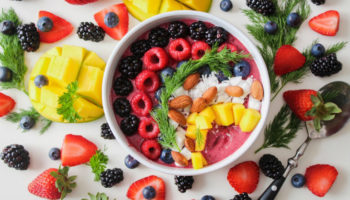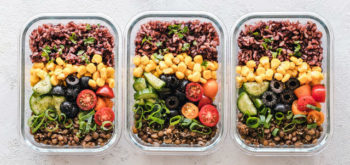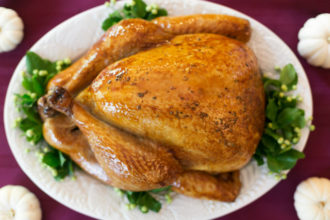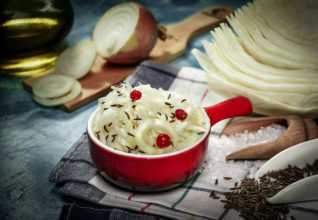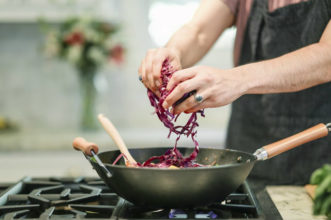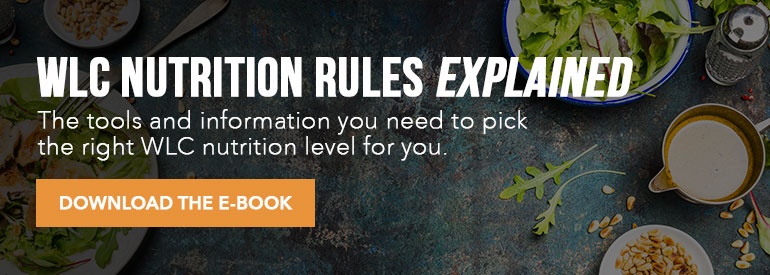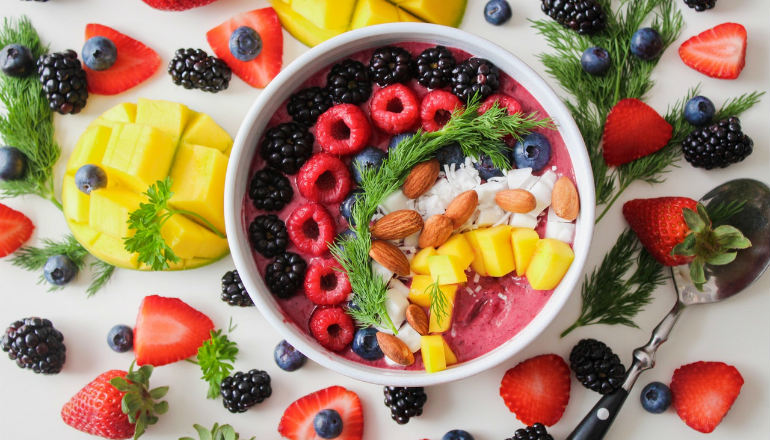 Reading Time: 8 minutes
Reading Time: 8 minutesThere are two common sayings about health and fitness that I cannot stand:
- Eat less and move more.
- Food is fuel.
I think these phrases, while not incorrect, belittle the process of becoming healthy. And, as a consequence, these sayings belittle each of us and also our triumphs and challenges when it comes to our nutrition choices.
“Food as fuel” is only one part of what food does for us. It provides calories and energy, yes, but it also gives us important vitamins and minerals. Food is also about family memories, traditions, and both happy and sad times. Society used to be built around the process of gathering, preparing, and eating food together. In modern times, cooking and food in general has become more of an inconvenience and “food is fuel” only supports this unhealthy approach.
Eating less while moving more sounds easy. Just stop eating, and start walking, right? Unfortunately, it’s an easy phrase to say but much different in practice. Eating less is a much more complex process considering our survival instincts tell us not to. In “eating less,” we also gravitate toward “diet” food, which does consist of low calories but also low nutrients. Think of foods like those 100-calorie packets, zero-fat dairy products, and all those bars and shakes.
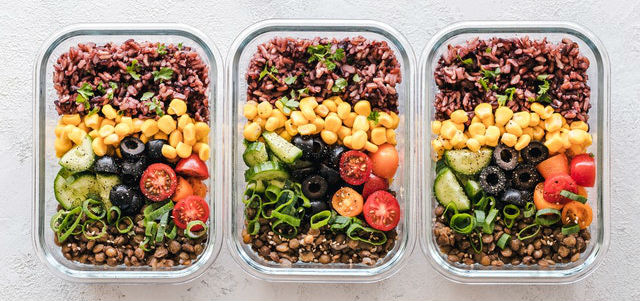
So what phrase do I prefer? The word I use is “nourishment.” Instead of “eat less” or “fuel your body,” think of nourishing your body. It’s a much different perspective that will lead you to making better choices.
Just because something is low calorie, or has the right ratio of protein and carbohydrate, doesn’t mean it is nourishing to your body. In fact, if you eat more wholesome foods, you’ll typically eat fewer calories because you will be satisfied and your body will have the right nutrients. You will squash that background craving for something more by providing your body with more wholesome foods.
What do I mean by more wholesome, nutritious, nourishing foods?
Doing things like the Whole Life Challenge and eating more vegetables and quality food in general is obviously the bulk of it. However, I want to share a few strategies that can help kick start your new nourishing approach to food even more.
These three strategies are things I’ve noticed over the years that help me as well as the people I have coached. The aim with these strategies is to provide yourself with a wide range of nutrients like minerals, fiber, and a variety of proteins.
1. Make Bone Broth and Cabbage
Instead of looking for the newest superfood, try a take on some traditional fare. Broth — made from poultry, beef, pork, or fish bones — along with seasoning and vegetables, is one of the best nourishing foods.
Broth provides a nice blend of amino acids, the building blocks of protein, in a much different ratio then regular meat. Therefore, consider it a food that can balance your proteins. It provides collagen and several minerals depending on the type of bones used. On a cold day, nothing beats a well-made broth to warm up your body. It’s also a great way to honor the animal by using more of its sacrifice.
Cabbage is an extremely underrated vegetable. Cabbage is packed full of nutrients, including vitamin C, K, B6, folate, copper, phosphorous, manganese, among many others. More importantly, it keeps you full for a lot longer than most foods, in my experience. From a cooking standpoint, it’s a great food because it can soak up flavors from whatever you pair it with.
And guess what? Cabbage and broth make for exceptional partners. Take a batch of fresh broth and simmer in chopped cabbage for an extra hour, and you’ll have a great base for a soup. You can enjoy just the cabbage broth soup or add any meat, vegetable, or spice.
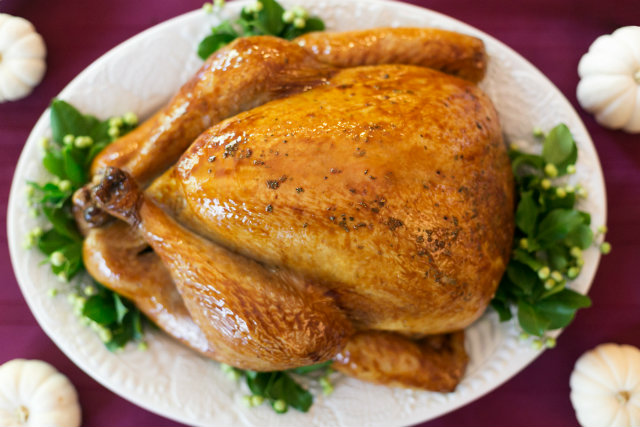
Here’s what I recently did (and, remember, you can vary this basic technique any way that suites you):
Thanksgiving Turkey Carcass Broth
- After taking off most of the meat, the bones are ready for broth. I used a large pot on the stove, but slow cookers and pressure cookers are other great methods as well.
- Add 2 onions, 5 carrots, a couple mushrooms, salt, pepper, and a few bay leaves.
- Fill the pot with enough water to cover the bones and vegetables.
- Let it simmer for about 4 hours.
- Drain the broth through a strainer.
- From here you can store in covered Tupperware, freeze, or refrigerate. If you want to make it into a soup right away, put the broth into a separate pot and add your soup ingredients.
I then cut up half the cabbage into thin strands and let them simmer into the broth for about an hour. I also added carrots, celery, and mushrooms to the final soup. This is a nourishing soup to have with any meal — and you can feel good about it.
2. Eat Fermented Foods
Instead of cooking food, you can let bacteria process it for you. Ferments — like sauerkraut, kimchi, and kombucha — are full of healthy bacteria that is great for your digestion. Fermented foods actually enhance the amount of nutrients you would get from the original ingredients. Foods like sauerkraut are full of great B vitamins.
Fermented foods also make for great flavorings with many dishes. Besides the traditional sauerkraut and sausage combinations, sauerkraut is perfect on a slow-cooker roast, blended into meatloaf, or in a chicken saute.
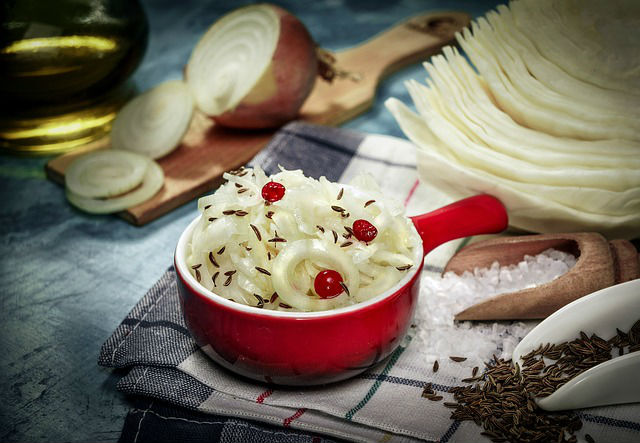
You can buy “live” fermented foods at the store, but you can also easily make them yourself and have even more pride in your food and what you put in your body. Try my sauerkraut recipe:
Easy Homemade Sauerkraut
Ingredients:
- Half a head of cabbage (could even be the other half from the soup)
- 2-4 teaspoons of sea salt
Directions:
- Chop the cabbage finely.
- Mix in a bowl with the salt.
- Cover and let sit for a half hour. By leaving the salted cabbage covered, the salt helps leach fluid from the leaves.
- Squeeze and knead the cabbage (with clean hands) in the bowl until you have brine forming.
- Shove the contents into a small jar, packing tightly and having the brine cover the contents.
- Lightly put the lid in the jar and let sit for a week.
- Loosen the lid daily to make sure the gas that is forming can escape, and make sure the brine is still covering the cabbage. If not, push the cabbage back under the brine with clean hands.
- In about a week, taste test to see if it is to your liking. Let it sit and taste daily until you like the flavoring.
Once you’re experienced with how simple it is to make sauerkraut, you can start experimenting with adding spices. Caraway seed is a common ingredient.
3. Take on a Home-Cooked Experiment
I call this strategy an “experiment,” because while it can be challenging, it’s more about seeing how this approach makes you feel. It’s a very subjective experiment, but a worthy one indeed:
Prepare everything you eat at home for at least a week, but preferably two weeks.
This means no eating out, take-out, or things like bars in packaging. I’m not saying you must prepare everything from scratch but do the best you can. To me, “scratch” would mean everything freshly picked, prepared, and spiced on your own. Obviously depending on your free time, season, and skill level, this can be difficult. So, with that in mind, eating packaged cereal wouldn’t be okay on this experiment, but buying pre-sliced veggies, canned beets, and jar tomato sauce would be great. Think stuffed peppers, not Hamburger Helper.
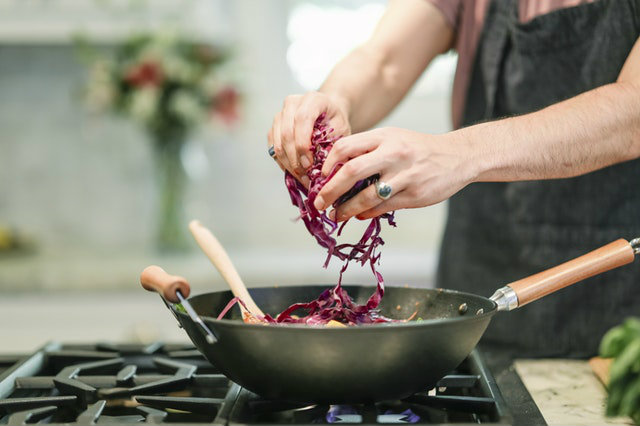
To help you with this experiment, the broth and fermented foods have given you a head start. Simply prepare a protein and perhaps one or two vegetables and you’ll have your meals.
The broth can be used:
- As a vegetable soup
- As a liquid for lightly sauteing vegetables
- In place of water for things like quinoa
- For cooking proteins like chicken in an inch or two of broth to keep it from drying out
Sauerkraut, kimchi, or similar ferments can be used as a side dish or as a garnish. I use fermented onions as a topping for basic proteins like chicken or fish. To make fermented onions, simply use the same sauerkraut recipe but add garlic.
For at least a week, every single thing you eat should come from something you prepared. For some, this can be quite a radical change. For others, it can be a reminder of the importance of cooking at home and food prepping. Take note of how the experiment makes you feel. Perhaps you will have more energy, better digestion, and less hunger. At worst, you’ll have more money in your pocket and will have learned a few new recipes.
Food Is Not Fuel — Food Is Nourishment
Regardless of what you choose to eat, whether it be all home cooked, soups, sauerkraut, or a family recipe, think of your food through a new lens. Forget the “diet” trends. Instead, ask yourself if this food is something that will make your body smile.
In general, eating better and more nourishing foods will also coincide with any weight loss or body composition goals you have. You’ll find it easier to eat less yet feel great. The more love the food is made with, the better it will be for you.
Forget about “eat less, move more” or looking at food as pure fuel. What we eat is a part of us that is much bigger than just a basic energy exchange.
